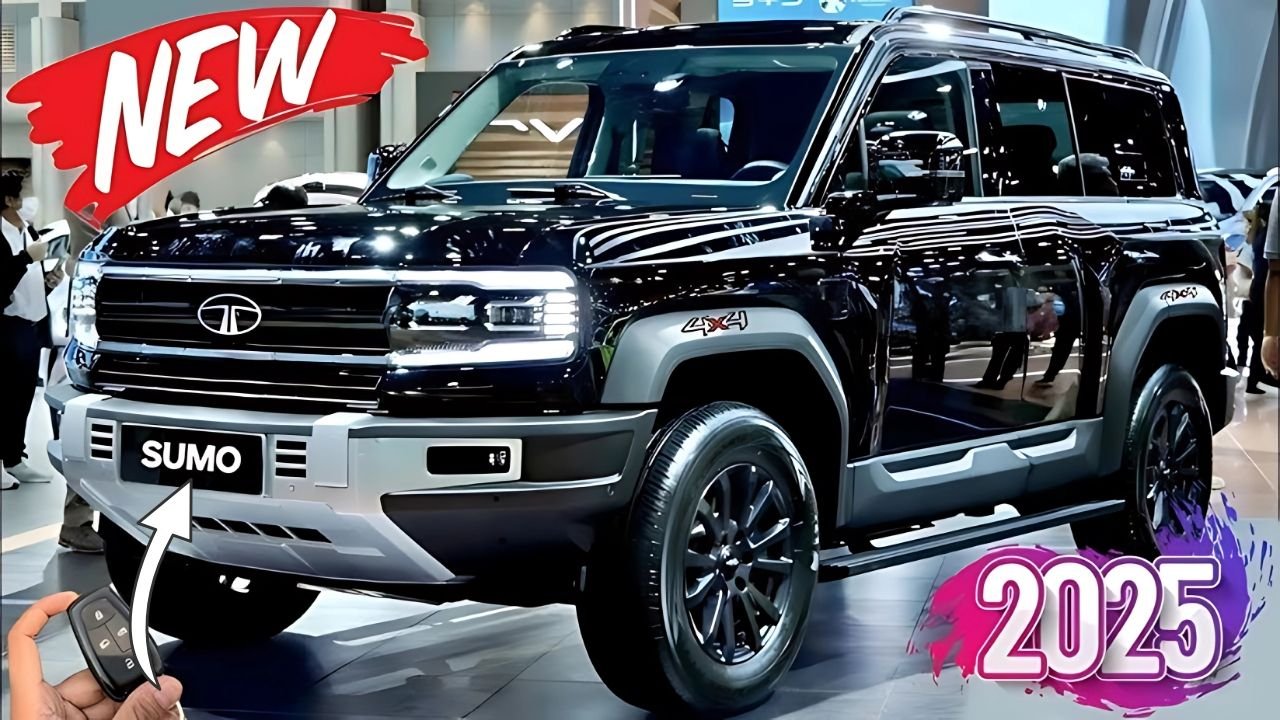In the fast-paced evolution of electric mobility across India, few names stir nostalgia and national pride quite like the Tata Sumo. Once the go-to SUV for families, government agencies, and rugged rural duties, the Tata Sumo now stands poised for a groundbreaking revival. With Tata Motors’ aggressive push toward sustainable transportation, the return of this legendary nameplate as the Tata Sumo EV isn’t just a strategic product move—it’s a statement of purpose.
This all-electric reincarnation of a beloved classic blends heritage with high-tech aspirations, presenting a vision of what the future of practical Indian mobility can be.
Legacy of the Original Tata Sumo
To understand the emotional impact of the Tata Sumo EV, we must first appreciate the original Sumo’s place in Indian automotive history. Launched in the early 1990s and named after Sumant Moolgaokar, a legendary Tata figure, the Tata Sumo quickly became a symbol of durability, utility, and affordability.
With its boxy exterior, utilitarian charm, and go-anywhere capability, it was more than just a car—it was a trusted workhorse. Its high ground clearance, robust build, and spacious interior made it the default choice for families, rural dwellers, transport operators, and even the Indian armed forces.
Despite its modest 85 horsepower diesel engine, the original Sumo delivered on dependability and value. However, it eventually bowed out in 2019, a victim of tightening emission norms, modern safety expectations, and shifting consumer preferences.
Yet even after its discontinuation, the Sumo name retained its legendary status, a dormant asset in Tata’s lineup—until now.
Tata Motors’ Electrification Strategy: The Perfect Launchpad
Tata Motors isn’t dipping its toes into EVs—it’s diving headfirst. With a roadmap to launch at least 10 new electric vehicles by 2025, the brand has already carved out a dominant space in the Indian EV market through models like the Nexon.ev, Tiago.ev, Tigor.ev, and Punch.ev.
This electrification movement is driven not just by vehicles but by a larger vision: the Tata UniEVerse—a unified, holistic ecosystem where Tata Group companies collaborate on batteries, charging infrastructure, clean power generation, recycling, and financing.
Reintroducing the Sumo nameplate as the Tata Sumo EV fits seamlessly into this strategy. It’s more than just electrifying an old model—it’s about using Tata’s history to craft India’s clean transportation future.
Reimagining Design: Where Old Meets New
While Tata hasn’t officially revealed the Sumo EV yet, design speculation and leaked concepts offer a fascinating glimpse into what we can expect. The Tata Sumo EV will likely retain its iconic upright stance and tough silhouette, but updated with smoother contours, LED lighting, and aerodynamic design enhancements.
Gone will be the diesel grille—replaced by a modern, closed-off front fascia ideal for EVs. Expect signature lighting that aligns with Tata’s electric lineup, especially features like LED DRLs and a floating roof design.
Inside, the transformation will be even more pronounced. The interior of the Tata Sumo EV will depart from its utilitarian roots to offer premium comfort, tech integration, and high-quality materials. A digital instrument cluster, large touchscreen infotainment system, connected tech features, and Tata’s futuristic two-spoke steering wheel will likely take center stage.
Also Read – The Rare Bicentennial Quarter Valued at $78 Million, Still in Circulation
This balance of classic structure and modern technology is key to its appeal—keeping the nostalgia intact while ensuring it meets the expectations of 2025 and beyond.
Tata Sumo EV: Projected Performance & Specifications
While Tata Motors hasn’t confirmed exact specs yet, industry insiders and trends provide compelling projections. The Tata Sumo EV will most likely be built on Tata’s advanced Gen 2 or Gen 3 EV platform, designed specifically for electric powertrains.
Key expectations include:
- Battery Capacity: Likely between 60–80 kWh, ensuring a real-world range of 400–500 kilometers on a single charge.
- Charging: Support for 100 kW DC fast charging and AC charging with plug-and-play convenience. Fast charging can replenish 80% battery in under an hour.
- Drivetrain: Dual-motor setup offering All-Wheel Drive (AWD) capabilities for enhanced performance on rough terrains—perfect for adventure seekers.
- Power Output: Anticipated 200 kW (270 hp), with electric torque delivery enhancing off-road and city performance.
- Vehicle-to-Load (V2L) and Vehicle-to-Vehicle (V2V): Enabling the Sumo EV to serve as a mobile power source—ideal for camping, field operations, or emergency services.
- ADAS Features: Advanced Driver Assistance Systems like adaptive cruise control, lane assist, and autonomous emergency braking will elevate safety standards.
With this spec sheet, the Tata Sumo EV promises not only to revive a legacy but to redefine utility SUVs in the electric era.
Target Audience: From Families to Fleet Operators
One of the Tata Sumo EV’s greatest strengths lies in its broad market appeal. It’s designed to cater to:
1. Eco-Conscious Families
Urban and suburban households looking for a robust, spacious, and eco-friendly SUV will find the Sumo EV irresistible. It will serve as the perfect family hauler with zero tailpipe emissions and state-of-the-art features.
2. Adventure & Off-Road Enthusiasts
With projected AWD capabilities and long range, the Tata Sumo EV becomes a dream SUV for those who love exploring India’s offbeat destinations. Combined with portable power options and rugged build, it’s a compelling choice for campers and explorers.
3. Premium Transport Services
Fleet operators, hotels, and corporate services will appreciate its spacious interiors, upscale comfort, and green credentials. The Tata Sumo EV could become a go-to option for eco-luxury transportation.
4. Rural Markets
Even rural users—historically loyal to the Sumo—might find a compelling upgrade path here, especially with Tata’s expanding service and charging network.
Price and Market Positioning
Given its premium positioning, the Tata Sumo EV is expected to start around ₹20 lakh, with higher-end variants possibly stretching to ₹30 lakh+. This would place it above the Nexon.ev but potentially below luxury EVs, making it a unique bridge between mass market and premium electric SUVs.
It also serves as a more emotionally engaging alternative to upcoming EVs like the Harrier.ev, Safari.ev, or even Mahindra’s rumored electric Bolero—its age-old rival in diesel form.
Tata Sumo EV vs. the Competition
In the competitive landscape of India’s electric SUV segment, standing out requires more than specs. The Tata Sumo EV has several key differentiators:
- Heritage Appeal: The emotional legacy of the original Sumo creates instant brand recognition.
- Practical Versatility: Combines off-road strength with urban usability.
- Eco-System Advantage: Tata’s UniEVerse approach, including fast-growing infrastructure and after-sales support, gives it a unique edge.
- Sustainability Focus: From recyclable materials to clean energy partnerships, the Tata Sumo EV is aligned with global and national sustainability goals.
Challenges on the Horizon
Despite its many strengths, the Tata Sumo EV will have to overcome several hurdles:
- Pricing Pressure: EVs still carry premium costs, especially in larger battery formats. Tata will need to balance affordability with innovation.
- Charging Infrastructure: While expanding rapidly, charging availability in remote and rural areas still lags, a concern for long-distance travelers.
- Range Anxiety: Though projected ranges are competitive, many customers remain wary of battery-powered long-distance driving.
- Consumer Education: Tata must continue educating the public about EV benefits, maintenance savings, and ecosystem services.
The Road Ahead for Tata Sumo EV
The Tata Sumo EV isn’t just a new product—it’s a strategic masterstroke. It allows Tata Motors to leverage one of its most beloved legacies while aligning with India’s push toward zero-emission mobility.
As climate consciousness grows, and electric vehicle technology becomes more mainstream, the Tata Sumo EV is uniquely positioned to appeal to both nostalgic buyers and forward-thinking consumers. If executed well, it could not only revive a classic but also set a new benchmark for rugged electric SUVs in India.
In essence, the Tata Sumo EV symbolizes a journey—where tradition meets transformation. It’s not just about bringing back a name. It’s about bringing back a feeling—and electrifying it.
Some Important Link
| Telegram Group | Click Here |
| WhatsApp Group | Click Here |
| Home Page | Click Here |










